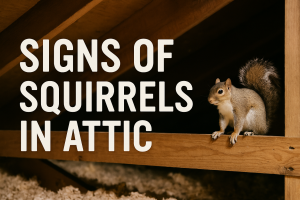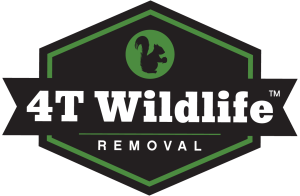Signs of Squirrels in the Attic: What Huntsville Homeowners Need to Know

If you’ve been hearing strange noises overhead, you’re not losing your mind — you may just have some uninvited, furry squatters living above you.
In Huntsville, AL, it’s common for squirrels to take up residence in attics, especially during cooler months or after a storm. They’re nimble, persistent, and surprisingly destructive.
Knowing the early signs of squirrels in the attic can help you avoid chewed wires, ruined insulation, costly repairs — and the stress that comes with it.
Let’s walk through the real signs, what they mean, and what you should do next.
Why Squirrels Love Your Attic (and What Makes Huntsville a Hotspot)
Squirrels are resourceful, agile climbers who are always on the hunt for:
- Shelter from predators
- Warmth during cooler nights
- Safe places to raise their young
Your attic? It checks all the boxes.
Especially if:
- You live near wooded areas like Monte Sano, Hampton Cove, or Jones Valley
- Your home is over 10 years old
- You’ve recently had roofing, gutter, or siding repairs
- You store bird seed, pet food, or firewood nearby
Squirrels are more than just backyard visitors. They see your home as prime real estate.
Top Signs You Might Have Squirrels in the Attic
You don’t have to see a squirrel to know one’s taken up residence. Here are the most common (and urgent) red flags:
1. Scratching or Scampering Sounds
The #1 complaint we hear from Huntsville homeowners?
“Something’s running in my ceiling at dawn.”
Squirrels are active during the day — especially early morning and around sunset. You’ll often hear:
- Scratching in ceiling corners
- Quick footsteps or skittering above your head
- Sounds that start around 5–6AM and stop mid-day
2. Chewed Wood, Wires, or Entry Points
Squirrels chew constantly to keep their teeth sharp. That means:
- Damaged soffits, shingles, or fascia boards
- Frayed electrical wiring (a major fire hazard!)
- Chew marks around vents or attic openings
If you’ve had electrical flickers, odd smells, or chewing around your roofline — that’s a solid clue.
3. Insulation That Looks Disturbed or Flattened
In most squirrel-infested attics, we find:
- Flattened insulation where they nest
- Tunnels or pathways through blown-in insulation
- Nesting materials like leaves, twigs, and even cardboard
This impacts your energy bills and your indoor air quality.
4. Droppings in the Attic or Garage
Squirrel droppings are small, oblong, and dark — often mistaken for mouse or rat droppings.
If you spot droppings near insulation or corners, that’s a red flag.
5. Nests Near Vents, Chimneys, or Eaves
From the outside, look for:
- Clumps of debris tucked in gutters or along the roofline
- Twigs and leaves sticking out of vents
- Noisy squirrel activity around your roof early in the morning
These are signs that squirrels are entering — or trying to.
6. Unusual Odors
Urine, droppings, or dead animals can create a strong musky smell in attics or even vents.
If your attic suddenly smells “off,” it’s time to take a closer look.
7. Your Dog or Cat is Acting Weird
If your pet is:
- Barking or growling at walls
- Scratching at garage doors or ceilings
- Constantly staring at a particular corner
… they probably hear something you don’t.
Why It’s a Bigger Deal Than You Think
Squirrels may be small, but the damage they do can be big:
- Fire risk: Chewed wires spark attic fires every year
- Insulation loss: Reduces energy efficiency
- Structural damage: They rip into wood, shingles, and vents
- Health risks: Droppings can carry bacteria or parasites
- Breeding cycle: If they nest, you’ll have a family of squirrels in no time
And once they’re inside? They’re hard to evict — especially without the right tools and training.
Huntsville Homeowners at Highest Risk
You’re more likely to deal with attic squirrels if:
- 🏡 You live in a home over 15 years old
- 🧒 You’ve got kids or pets
- 🌳 Your backyard backs up to trees or open land
- 🔌 You’ve had flickering lights or power issues
- 📦 You store boxes or holiday items in the attic
- 🛠️ You’ve recently had roof or gutter repairs
- 👂 You’re home more during the day (remote work or retirement)
- 💡 You’ve noticed odd smells or increased energy bills
- 🐕 Your dog has been barking at the ceiling or walls
Homes in South Huntsville, Blossomwood, and the Cove area are especially vulnerable — and squirrels are known to return year after year if not properly excluded.
Why DIY Fixes Usually Fail
Trying to patch a hole with steel wool or duct tape? That might stop mice — but squirrels are a different story.
Most DIY efforts backfire because:
- You miss secondary entry points
- You trap squirrels inside, causing more damage
- You use weak materials that get chewed through
- You violate wildlife laws on exclusion timing (especially with babies involved)
Plus, climbing on your roof or crawling into your attic with a flashlight isn’t exactly safe — or fun.
How 4T Wildlife Removal Handles It
We specialize in squirrel exclusion, not just removal. Here’s what to expect:
✅ Full-Home Inspection
We find all the entry points, not just the obvious ones. That includes roof gaps, dryer vents, and hidden eaves.
✅ Humane Squirrel Removal
If squirrels are already inside, we safely evict them using one-way doors and non-lethal traps.
✅ Entry Point Sealing
We seal your home with chew-resistant mesh, hardware cloth, and weatherproof sealants.
✅ Nest & Droppings Cleanup
We remove contaminated insulation, sanitize the area, and deodorize to prevent future interest.
Take Action Before the Nest Grows
If you’ve noticed even one of these signs — it’s time to act. Squirrels don’t wait, and neither should you.
📅 Schedule an inspection with 4T Wildlife Removal 256-975-2014


